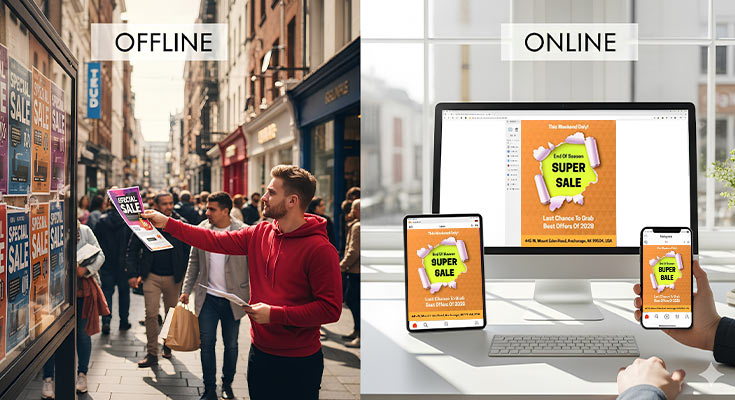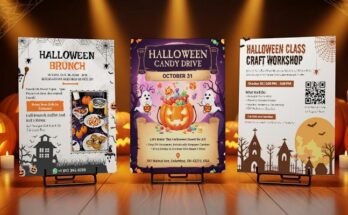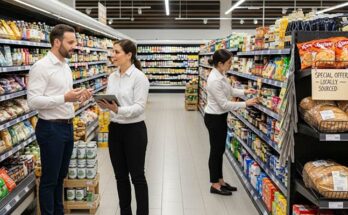Distributing AI-generated flyers effectively requires a clear strategy that combines both physical and digital channels. While an AI flyer generator streamlines the design process, reaching the right audience depends on smart placement. High-traffic locations like libraries, cafés, and community centers offer strong local visibility, while social media, email campaigns, and QR codes extend that reach online. This guide covers where and how to distribute AI-generated flyers to ensure maximum impact and measurable results.
Understanding the Power of AI Generated Flyer Distribution
AI-generated flyers distribution maximizes reach by combining high-quality, targeted designs with strategic placement across local and digital channels. For Q2-Q3 campaigns, flyers in community hubs, targeted social media ads, and email blasts drive engagement for events and businesses. Analytics track performance, ensuring cost-effective promotions that boost local visibility and conversions through data-driven optimization.
Why Distribution is Key to Flyer Success
The most stunning AI Generated Flyers fail without proper distribution strategy. Distribution amplifies your flyer’s impact by connecting compelling visuals with the right audience at optimal moments. Strategic placement in high-traffic locations and targeted digital channels transforms marketing materials from static designs into dynamic promotional tools that drive measurable results.
Effective distribution aligns with Q2-Q3 event and sales seasons when audiences actively seek local activities and promotional offers. This timing maximizes engagement while balancing reach with budget constraints. Rather than hoping audiences discover your flyers, strategic distribution ensures your marketing collateral reaches potential customers when they’re most receptive.
Unique Advantages of AI Generated Flyers for Distribution
AI-generated flyers offer distinct distribution advantages over traditional promotional design. High-quality visuals optimize for both print and digital formats, ensuring consistent brand presentation across all channels. Customizable designs allow real-time targeting for local audience preferences, while scalable creation supports multi-channel campaigns without expensive redesign costs.
The technology integrates seamlessly with analytics platforms, enabling performance tracking that traditional flyers cannot match. AI flyers adapt to different distribution channels – from high-resolution community board prints to mobile-optimized social media posts – maintaining visual impact across formats.
Strategic Distribution for Maximum Impact
Strategic distribution requires understanding your target audience’s behavior patterns and where they naturally engage, both offline and online. As effective channels rely on both physical delivery and the exchange of information, which are essential for reaching customers efficiently and maximizing impact.1
High-traffic locations like coffee shops, libraries, gyms, and community centers help brands connect with audiences in their daily routines. Meanwhile, digital platforms such as Instagram, Facebook, and local forums allow for precise targeting. Email lists also offer direct communication with already-interested users. To ensure measurable returns, use QR codes, unique promo links, and analytics to track which channels deliver the best engagement—then adjust your strategy accordingly.
According to Mariadoss, effective distribution channels involve two key flows—exchange and physical—that ensure products reach customers efficiently. These flows enhance customer satisfaction, reduce costs, and strengthen market presence through well-structured channel strategies.1
Timing Distribution for Q2-Q3 Success
Q2-Q3 represents peak promotional periods when communities actively seek local events and businesses launch seasonal campaigns. Distribute AI generated flyer content 2-3 weeks before target events, allowing sufficient time for audience awareness and response.
Coordinate distribution across multiple channels within concentrated timeframes for maximum impact. Launch digital campaigns first to generate initial buzz, followed by physical distribution to reinforce messaging. This sequenced approach creates multiple touchpoints that increase audience recall and engagement.
An AI flyer generator provides professionally crafted templates optimized for both print and digital channels. It intelligently selects layouts, visuals, and fonts based on your content to ensure each flyer maintains a strong visual presence. Whether pinned to a local bulletin board or shared across social media, your message stays clear and eye-catching. This smart design approach helps campaigns capture attention and drive conversions during high-impact promotional seasons.
Strategic distribution transforms AI-generated flyers from static designs into dynamic marketing tools that connect with audiences precisely when and where they’re most receptive, maximizing promotional effectiveness and measurable business results.
Local vs. Digital Distribution: A Dual Approach
Local distribution leverages community trust and physical presence. Community boards, local businesses, and event venues provide targeted reach within specific geographic areas. Physical flyers create tangible connections, particularly effective for neighborhood events and local business promotions.
Digital distribution offers broader reach and precise targeting capabilities. Social media platforms, email campaigns, and local online groups enable audience segmentation based on demographics, interests, and behaviors. Digital channels provide immediate analytics, allowing real-time optimization of promotional flyer campaigns.
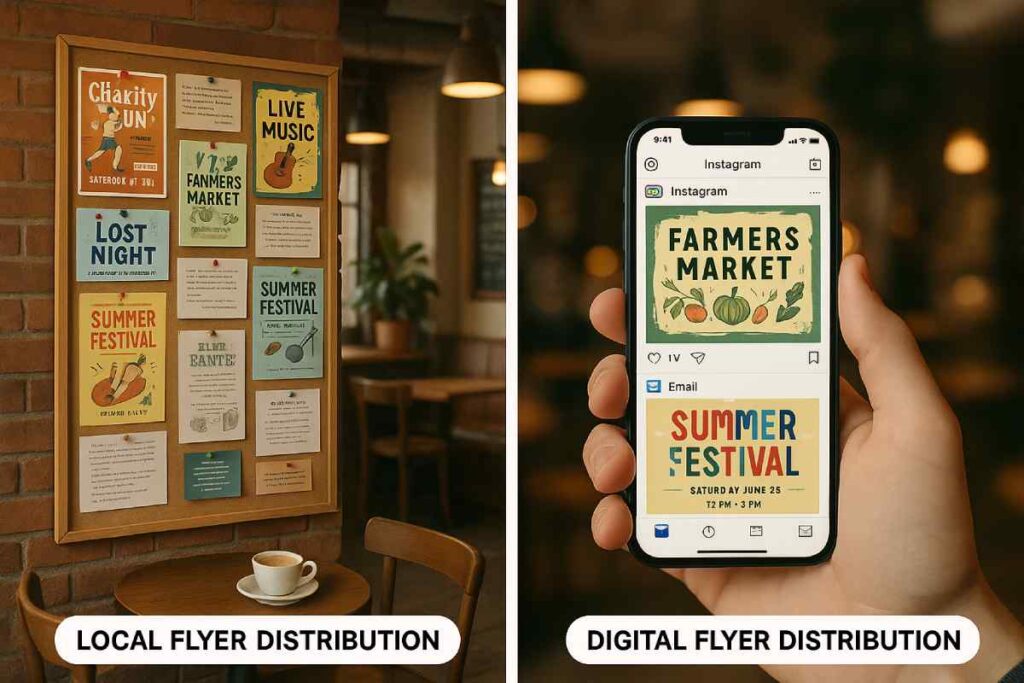
The most effective approach combines both strategies. QR codes on physical flyers bridge local and digital channels, while consistent branding across formats reinforces message recognition. This dual approach maximizes promotional design impact by leveraging local credibility alongside digital scalability.
Local Distribution Channels for AI-Generated Flyers
Distribute AI-generated flyers through local channels like community boards, coffee shops, and business partnerships for maximum reach. High-traffic physical locations combined with strategic partnerships drive engagement during peak promotional periods. Local distribution leverages community trust and face-to-face connections to boost event attendance and business visibility through targeted placement and grassroots marketing approaches.
Local Business Partnerships
Coffee shops are ideal spaces for distributing flyers to a community-focused audience. A tech conference flyer is being handed across the counter, while another flyer promoting a summer party is ready to be shared. On the wall, multiple event flyers like art exhibitions and wellness fairs are neatly displayed, showing how local businesses can help promote a variety of events.
This kind of setup reflects how partnerships with local shops create natural opportunities for flyer placement. Businesses that aren’t direct competitors but share similar audiences like a coffee shop and a wellness event organizer can cross-promote each other. Displaying flyers at checkout counters or bulletin boards builds visibility and trust within the neighborhood.
Such collaborations are especially effective for seasonal campaigns. Spring events can partner with cafés and garden stores, while winter promotions can find a home in indoor venues like restaurants and hobby shops. These relationships expand distribution without extra marketing spend.
Event-Based Distribution
Farmers markets, community festivals, and local gatherings offer direct audience engagement opportunities. These venues attract people already interested in community activities, making them receptive to additional event information. Distribute AI-generated flyers that complement the event atmosphere through relevant messaging and visual appeal.
Volunteer coordination enhances distribution effectiveness at community events. Train volunteers to engage naturally with attendees, explaining event benefits rather than simply handing out materials.
Timing matters significantly for event-based distribution. Arrive early to secure prime positioning and capture attendees when they’re most receptive. Late arrivals often face crowded conditions and distracted audiences.
Strategic Placement Tips for Local Reach
Design considerations dramatically impact local distribution success. Use vibrant colors and clear, readable fonts that stand out on crowded bulletin boards. AI-generated flyers should include essential information prominently: event details, contact information, and compelling visuals that communicate value quickly.
QR codes bridge physical and digital engagement, allowing instant access to additional information, ticket purchases, or RSVP systems. Position QR codes prominently with clear instructions like “Scan for instant tickets” or “Get event updates.” This approach captured more RSVPs for a festival through strategic QR code placement.
Permission protocols prevent distribution problems and build positive community relationships. Always request permission before posting materials, respect posting guidelines, and remove outdated flyers promptly. Property managers and business owners appreciate courteous approaches and often provide valuable placement advice.
Weather protection ensures flyer longevity and professional appearance. Use laminated materials for outdoor placement or protective covers for extended exposure. Damaged or weathered flyers reflect poorly on your event or business.
Community Hubs: High-Traffic Physical Locations
Coffee shops, libraries, and community centers serve as prime distribution points for AI-generated flyers. These venues attract diverse audiences throughout the day, creating natural touchpoints for promotional materials. Libraries typically maintain designated bulletin boards with high visibility, while coffee shops offer relaxed environments where customers spend time reading posted information.
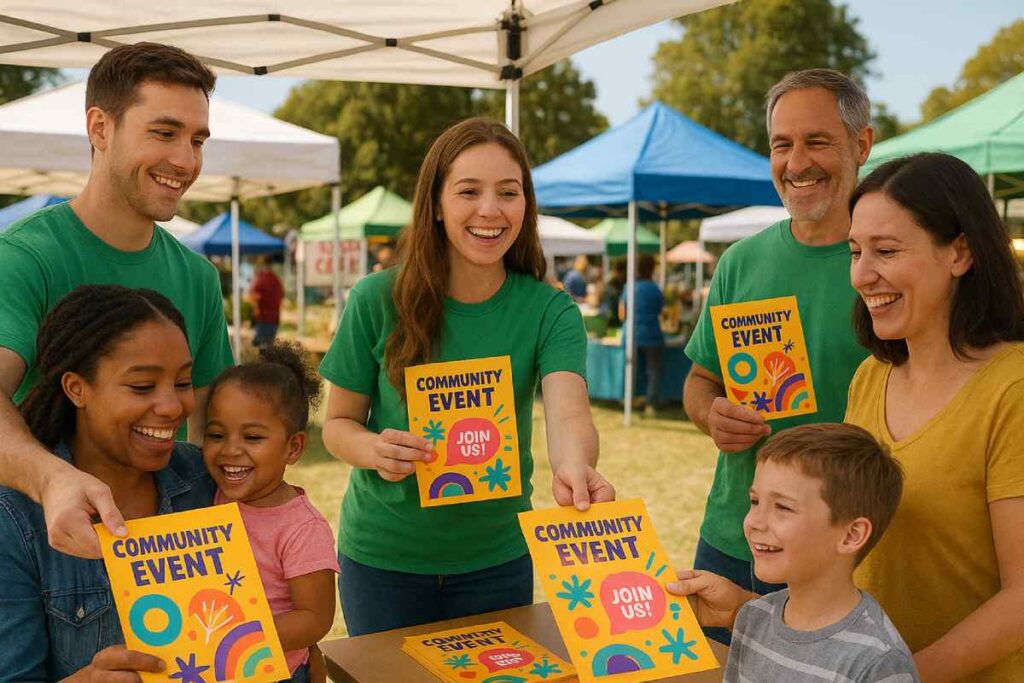
Grocery stores and gyms provide excellent placement opportunities due to consistent foot traffic and extended visitor duration. Position flyers near entrances or checkout areas where people naturally pause. Gyms work particularly well for health-related events, fitness classes, or wellness services, creating targeted audience alignment.
Target high-traffic areas during peak hours for maximum visibility. Morning coffee shop visits, lunch-time library usage, and evening gym sessions represent optimal placement windows. A local music festival achieved 40% higher attendance by placing vibrant AI-generated flyers in strategic coffee shop locations during morning rush hours.
Tracking Local Flyer Performance
Unique tracking methods measure local distribution effectiveness and optimize future campaigns. Assign specific promo codes to different locations, enabling precise performance analysis. “COFFEE20” for coffee shop distributions and “GYM15” for gym placements provide clear attribution data.
According to the Data & Marketing Association, leaflet distribution campaigns achieve an average response rate of 4% and up to 11% campaign effectiveness, demonstrating how proper tracking enhances results and informs smarter decisions.2
Geographic tracking through location-specific phone numbers or website landing pages identifies highest-performing distribution channels. A Portland bakery used different phone extensions for various locations, discovering that library placements generated 3x more inquiries than coffee shop distributions.
Regular feedback and monthly reviews reveal audience reactions, optimize flyer and distribution, and guide strategy. Track response rates, conversions, and satisfaction to strengthen local impact through targeted, high-traffic placements and trusted partnerships.
Digital Distribution Channels for AI Generated Flyers
Distribute AI-generated flyers digitally via social media platforms, email campaigns, and local online groups to maximize reach. Optimize for mobile, use targeted ads, and integrate analytics during Q2-Q3 peaks to boost engagement. Digital AI flyer distribution drives clicks, shares, and conversions for events and businesses, leveraging platforms like Instagram and email for cost-effective, scalable promotion.
Social Media Distribution
Social media platforms provide immediate reach for AI-generated flyers. Instagram’s visual-first format makes it ideal for showcasing vibrant flyer designs, while Facebook’s targeting options help reach specific local demographics. X (formerly Twitter) works well for time-sensitive events with hashtag campaigns.
According to Umunna (2021), small businesses have successfully enhanced customer engagement by tailoring visual content and interactive formats (e.g., polls, hashtags, Story features) across Instagram, Facebook, and Twitter—demonstrating effective use of platform-specific distribution strategies.3
Post flyers during peak engagement hours: 6-9 AM and 7-10 PM for maximum visibility. Use platform-specific sizing—Instagram Stories (1080×1920), Facebook posts (1200×630), and LinkedIn updates (1200×627)—to ensure professional presentation.
Stories and live posts create urgency for time-sensitive promotions. Add interactive elements like polls (“Which design do you prefer?”) and swipe-up links to drive immediate action. LinkedIn performs well for professional events and B2B promotions.
Email Marketing Campaigns
Email distribution provides direct audience access with high engagement rates. Segment subscriber lists by location, interests, and past event attendance to personalize flyer content.
Design mobile-optimized email templates that showcase flyer visuals prominently. Include clear subject lines like “Exclusive Event Invitation” or “Limited-Time Offer Inside” to boost open rates. Place the flyer image above the fold with a compelling call-to-action button.
Automated email sequences work well for multi-day events. Send initial announcements, reminder emails, and last-chance notifications with updated flyer designs. Track metrics like open rates, click-through rates, and conversion rates to optimize future campaigns.
Integrate with local business newsletters and community publications. Partner with complementary businesses to cross-promote through their email lists, expanding reach to qualified audiences.
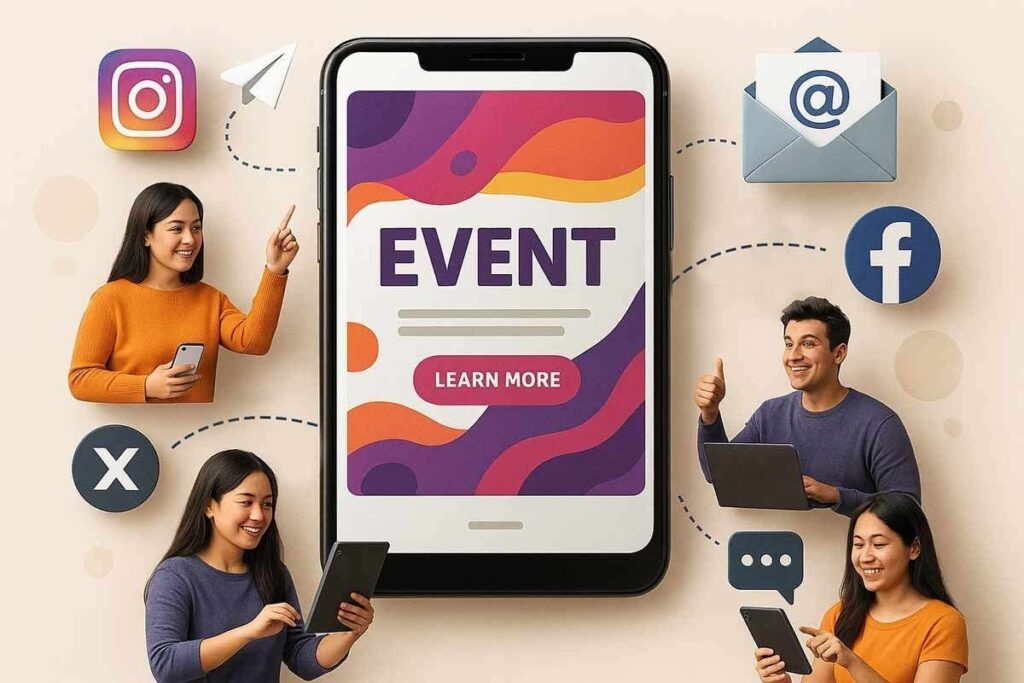
Local Online Communities and Forums
Neighborhood apps like Nextdoor and local Facebook groups provide targeted community reach. Share flyers in relevant community groups with engaging captions that encourage discussion and sharing.
Reddit’s local subreddits offer engaged audiences for specific geographic areas. Follow community guidelines carefully—focus on value rather than promotion. Include helpful context about the event or business to encourage upvotes and comments.
Local business directories and event listing sites amplify reach beyond social media. Upload flyers to Eventbrite, Meetup, and local chamber of commerce websites. These platforms often have built-in sharing features that extend distribution automatically.
Forum participation builds credibility before sharing promotional content. Engage authentically in discussions, answer questions, and provide value before posting flyers. This approach generates better response rates and community trust.
Optimization for Digital Performance
Mobile optimization remains crucial as 70% of users view digital content on smartphones. Design flyers with readable text at small sizes, high contrast colors, and clear calls-to-action. Test flyer visibility across different devices and screen sizes.
Use shortened URLs with tracking parameters to monitor click-through rates from different digital channels. UTM codes help identify which platforms drive the most engagement and conversions. Google Analytics provides detailed insights into user behavior after clicking flyer links.
A/B test different flyer variations across digital channels. Test color schemes, messaging, and call-to-action buttons to optimize performance. A Chicago retail sale campaign increased conversions by 25% by testing three different flyer designs across Facebook and Instagram.
Schedule posts for optimal timing based on audience behavior. Most social media platforms provide analytics showing when followers are most active. Email campaigns typically perform best on Tuesday through Thursday mornings.
Read more: How to Get Started with the ChatGPT DesignWiz AI Flyer Maker Plugin
Hybrid Strategies: Combining Local and Digital Distribution
Combine local and digital distribution of AI-generated flyers for maximum reach by integrating community board placements with social media and email campaigns. Use QR codes to bridge physical and digital channels, targeting Q2-Q3 peaks for events and businesses. Hybrid AI flyer distribution drives engagement, blending local trust with digital scalability for measurable results across diverse audiences.
Creating Seamless Cross-Channel Experiences
Hybrid distribution strategies leverage both local credibility and digital scale to maximize AI flyer effectiveness. Physical placements in community locations build trust through tangible presence, while digital channels provide precise targeting and instant engagement tracking. This dual approach ensures broader audience reach while maintaining cost efficiency.
QR codes serve as the critical bridge between physical and digital channels. When placed on community board flyers, these codes direct viewers to online registration forms, social media pages, or email signup platforms. This creates a seamless transition from physical discovery to digital engagement, enabling comprehensive tracking of campaign performance across all touchpoints.
Coordinated Multi-Channel Campaign Management
Successful hybrid campaigns require synchronized messaging across platforms. Maintain consistent visual branding and core messaging while adapting content format for each channel. Physical flyers emphasize location-specific information and clear contact details, while digital versions focus on interactive elements and social sharing capabilities.

Time coordination amplifies campaign impact. Launch physical distribution first to establish local presence, followed by digital campaigns that reference and expand upon the physical placement. This sequence creates recognition and reinforces messaging when audiences encounter your content across multiple channels.
Optimizing Local-Digital Integration
Design AI-generated flyers with dual-channel optimization in mind. Include both physical contact information and digital engagement elements. Physical versions feature phone numbers and addresses prominently, while digital versions emphasize clickable links and social media handles. This approach ensures effectiveness regardless of how audiences first encounter your content.
Strategic placement timing maximizes cross-channel synergy. Place physical flyers during high-traffic periods when target audiences are most active in community spaces. Simultaneously launch digital campaigns targeting similar demographics in the same geographic area, creating multiple touchpoints that reinforce your message.
Measuring Hybrid Campaign Performance
Track performance across both channels using unified metrics. Assign unique QR codes to different physical locations and use UTM parameters for digital campaigns. This allows precise measurement of which combination of channels drives the highest engagement and conversion rates.
Monitor cross-channel user behavior to identify optimization opportunities. Users who encounter your content both physically and digitally typically show higher engagement rates and conversion likelihood. Use this data to refine placement strategies and improve integration between channels.
Implementation Best Practices
Start with a pilot campaign in a limited geographic area to test hybrid effectiveness. A well-rounded flyer distribution strategy includes insights into timing, audience behavior, and cross-channel promotion. Choose locations where your target audience naturally moves between physical and digital environments, such as coffee shops with active social media presence.
Ensure consistent brand presentation across all channels. Use the same color schemes, fonts, and core messaging while adapting format for each platform. This consistency builds recognition and trust as audiences encounter your brand across multiple touchpoints.
Scaling Hybrid Distribution
Expand successful hybrid campaigns by replicating proven channel combinations in new markets. Document which specific combinations of physical placements and digital campaigns produce the best results, then systematically deploy these winning formulas across additional locations.
Use professionally designed flyer layouts optimized for both print and digital distribution to maintain visual consistency across all platforms. These designs help ensure your message remains cohesive and impactful whether shared online or posted in local venues.
Hybrid distribution transforms AI-generated flyers from single-channel tools into comprehensive marketing systems. By combining local credibility with digital precision, these strategies deliver measurable results that exceed what either channel achieves independently. Focus on seamless integration, consistent messaging, and comprehensive tracking to maximize your campaign’s impact across all touchpoints.
Best Practices for Maximizing AI Generated Flyer Distribution
Maximize AI-generated flyer distribution by targeting high-traffic local spots like community boards and cafes, while leveraging digital platforms including social media and email campaigns. Use clear CTAs, trackable QR codes, and analytics to measure performance. According to Shapiro (1977), aligning promotional tactics with distribution strategy is essential for maximizing impact—a principle that still applies in today’s hybrid marketing landscape.4 Strategic placement across both physical and digital channels can increase engagement by up to 40% during peak promotional periods. Focus on community relevance and mobile optimization to ensure AI-generated flyers reach target audiences effectively.
Strategic Placement for Maximum Visibility
Effective AI-generated flyer distribution requires strategic location selection. Place flyers in high-traffic community hubs where your target audience naturally congregates. Coffee shops, libraries, and grocery store bulletin boards offer consistent visibility. Community centers and fitness facilities also provide access to engaged local audiences, making them ideal for flyer placement.

Partner with complementary businesses for mutual flyer placement. A yoga studio can distribute AI generated flyers for healthy restaurants, while cafes can promote local wellness events. This cross-promotion leverages established customer relationships and builds community connections.
Digital Distribution Optimization
Digital channels amplify AI-generated flyer reach through targeted distribution. Share flyers across social media platforms using relevant hashtags and local community groups. Social media distribution significantly increases flyer visibility compared to physical placement alone.
Email campaigns deliver flyers directly to interested audiences. Segment subscriber lists based on interests and location for targeted distribution. Include mobile-optimized flyer designs that display clearly on all devices. Use compelling subject lines that highlight the flyer’s value proposition.
Design Elements That Drive Engagement
Use an AI flyer generator to create a flyer with clear visual hierarchy and compelling calls-to-action for your flyer distribution. Use bold headlines, contrasting colors, and readable fonts that work across print and digital formats. Include essential information without cluttering the design.
QR codes bridge physical and digital distribution channels. Link QR codes to event registration pages, discount offers, or social media profiles. Test QR codes before distribution to ensure functionality across different devices and scanning apps.
Timing and Frequency Strategies
Distribute AI generated flyers during peak audience activity periods. Research local foot traffic patterns and social media engagement times for optimal placement. Weekend mornings work well for community boards, while weekday lunch hours target working professionals.
Plan distribution campaigns 2-3 weeks before events or promotions. This timing allows for multiple touchpoints without oversaturation. Schedule social media posts during high-engagement hours and coordinate with email campaigns for maximum impact.
Multi-Channel Integration
Combine local and digital distribution for comprehensive reach. Announce physical flyer placement through social media posts to create buzz. Use email campaigns to drive traffic to social media, where flyers gain additional exposure through shares and comments.
Create consistent messaging across all distribution channels while adapting format for each platform. Physical flyers require different design considerations than social media posts, but core messaging should remain aligned.
Legal and Ethical Considerations
Obtain permission before placing flyers on private property or bulletin boards. Many businesses have specific policies about promotional materials. Research local regulations regarding flyer distribution in public spaces.
Respect community guidelines when posting in online groups. Contribute valuable content beyond promotional materials to build trust and credibility. Focus on providing helpful information rather than purely promotional messaging.
Measuring Success and Optimization
Track key performance indicators including engagement rates, conversion rates, and cost per acquisition. Compare performance across different distribution channels to identify most effective approaches. Use A/B testing to optimize flyer designs and distribution strategies.
Regularly analyze competitor distribution strategies to identify new opportunities. Monitor community response to adjust messaging and placement strategies based on audience feedback and engagement patterns.
Read More: Why Marketers Are Switching to AI Flyer Generator for Promotions
Tools and Technologies for AI Generated Flyer Distribution
Use tools like DesignWiz, QR code generators, and analytics platforms (Google Analytics, Bitly) to distribute AI-generated flyers effectively. Social media schedulers like Hootsuite and email platforms like Mailchimp enhance digital reach, while local partnerships streamline physical distribution. These tools optimize AI flyer promotion for Q2-Q3 campaigns, ensuring maximum engagement and conversions across local and digital channels.
Design and Distribution Tools
The AI flyer generator tool, such as DesignWiz, powers efficient marketing materials production by offering customizable flyer templates for both print and digital use. These platform ensure consistent branding across all marketing collateral while reducing design time.
QR Code Integration Tools bridge physical and digital distribution channels. QR Code Generator creates trackable codes linking flyers to event pages, surveys, or contact forms. Dynamic QR codes update destinations without reprinting, essential for evolving Q2-Q3 campaigns. Bitly provides URL shortening with click tracking for performance measurement.
Read more:- Best AI Flyer Generator Tools to Simplify Your Design Process in 2025
Digital Campaign Management
Social Media Distribution Tools amplify reach across platforms. Hootsuite schedules AI-generated flyers across Instagram, Facebook, and X simultaneously, optimizing posting times for maximum engagement. Buffer provides analytics tracking shares, clicks, and conversions from social media flyer campaigns. These tools ensure consistent digital presence during promotional periods.
Email Marketing Platforms deliver targeted flyer campaigns to segmented audiences. Mailchimp integrates AI-generated flyers into responsive email templates, tracking open rates and click-through performance. Constant Contact offers automated drip campaigns for event promotion, perfect for Q2-Q3 seasonal marketing pushes.
Performance and Analytics Tracking
Analytics Platforms measure distribution effectiveness across channels. Google Analytics tracks website traffic from QR codes and digital flyer links, providing conversion data for optimization. Facebook Pixel monitors social media flyer performance, enabling retargeting campaigns for increased engagement.
Local Distribution Support Tools streamline physical placement strategies. Google My Business posts flyers to local business profiles, reaching community audiences effectively. Nextdoor facilitates neighborhood-specific distribution, particularly valuable for local events and small business promotions.
Integration Strategy
Multi-Channel Coordination requires unified tool ecosystems. Zapier connects various platforms, automating flyer distribution workflows from creation to performance tracking. This integration ensures consistent messaging across promotional design channels while maintaining detailed analytics for campaign optimization.
Performance Optimization Tools enable data-driven distribution decisions. Hotjar provides heatmaps showing how users interact with digital flyers, informing design improvements. A/B testing tools like Optimizely test different flyer variations across distribution channels, maximizing engagement rates during critical promotional periods.
People Also Ask About AI Generated Flyer Distribution
Distribute flyers in high-traffic areas like coffee shops, libraries, and community centers. Collaborate with nearby businesses to display flyers on counters or bulletin boards for strong visibility during the April to September event season.
Post flyers on visual platforms and community forums using targeted content and hashtags. Schedule posts during evenings or weekends from April to September for better engagement.
Local placement builds in-person visibility and trust, while digital channels extend your reach. This combination works especially well during the busy April to September marketing window.
Segment your audience by location, age group, or interest. Customize flyer messaging for neighborhoods and tailor digital content to specific community preferences.
Use scannable QR codes that lead to landing pages, sign-ups, or special offers. Make sure codes are tested and easy to scan to encourage interaction and track campaign performance throughout April to September.
Avoid unclear messaging, poor visuals, or flyer placements that can’t be tracked. Prioritize strong design, focused calls to action, smart placements, and data-driven monitoring.
Distribute flyers from April through September to align with seasonal events, school breaks, and summer promotions. Schedule digital posts during high-engagement times like Friday evenings and weekends.
Use visual-based platforms for creative flyers, and neighborhood-focused apps or community groups for local promotions. Select platforms that match your target audience’s habits during the active April–September period.
Frequently Asked Questions
Yes. AI-generated flyers are designed for high-resolution print (8.5×11 inches) and mobile-optimized digital formats (1080×1080 pixels), making them versatile for April to September campaigns.
Use QR codes, unique URLs, or promo codes to monitor engagement. Track views, clicks, and redemptions to refine your distribution strategy throughout your April–September promotions.
DesignWiz simplifies flyer design and supports customization, printing, and digital sharing—helping businesses manage flyer campaigns more efficiently.
Always request permission from property owners or managers before posting flyers. Some public areas may require permits or limit where you can post materials.
Use location-based phone numbers, custom promo codes, or simple feedback questions to find out how customers discovered your flyer during April to September campaigns.
Use 8.5×11 inches for printed flyers to ensure legibility. For digital sharing, 1080×1080 pixels works best across social media platforms.
Use automation to create batches of personalized flyers. Distribute them through local partnerships and online platforms like social media and email from April to September for maximum exposure.
Design for small screens by using bold visuals, readable text, and fast-loading formats. Include clear QR codes and links to boost mobile interaction during the campaign season.
Conclusion and Implementation Strategy
Strategic AI flyer distribution blends community engagement with digital precision, maximizing visibility and response. By combining local placements with targeted online promotion, businesses can extend their reach, track performance, and adapt quickly. Leveraging an AI flyer generator ensures every flyer is optimized for both print and digital use, maintaining a strong visual presence across all touchpoints.
Flyer Distribution Implementation
Planning Essentials:
- Select 3–5 high-traffic local venues based on audience presence and relevance
- Choose 2–3 digital platforms that support targeted geographic or interest-based distribution
- Create print-ready and mobile-optimized flyers using an AI flyer generator
- Use QR codes to bridge physical and digital channels for seamless tracking
Optimization Strategy:
- Launch physical distribution first to build local visibility
- Follow up with digital campaigns via social media and email targeting
- Track performance using QR scans, promo codes, and analytics tools
- Scale efforts by replicating high-performing combinations in new markets
Reference
- Basics of Distribution Channels (Chap. 10.1). In Core Principles of International Marketing. Washington State University Open Textbooks. Mariadoss, B. J.
- Leaflet Response Rates and Campaign Effectiveness (2022). In What is the Response Rate from Leaflet Distribution? (Revised Edition). Data & Marketing Association (DMA)
- Social media marketing strategies and their impact on brand awareness in small businesses (Doctoral dissertation, Walden University). Walden Dissertations and Doctoral Studies. Umunna, J. N.
- Improve Distribution with Your Promotional Mix. In Harvard Business Review, March 1977. Shapiro, Benson P.
